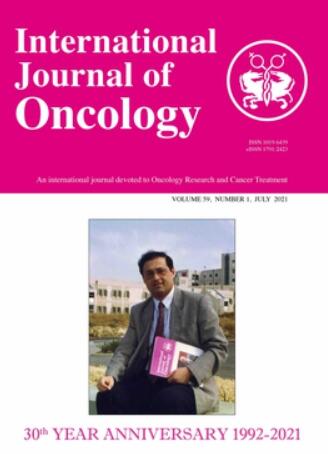通过上调 PPAR 通路,敲除 PGBD5 可抑制胶质瘤的恶性发展。
IF 4.5
3区 医学
Q1 ONCOLOGY
引用次数: 0
摘要
胶质瘤是颅内原发性恶性肿瘤中最常见的一种,由于其侵袭性强、复发率高,预后一直不佳。本研究探讨了神经胶质瘤中piggyBac转运蛋白5(PGBD5)的生物学功能。研究人员采集了五名患者的胶质瘤和癌旁组织。采用逆转录-定量 PCR 和 Western 印迹法检测 PGBD5 的表达水平。透孔试验和流式细胞术用于评估细胞迁移、侵袭、凋亡和细胞周期分布。此外,还建立了裸鼠肿瘤移植模型来研究PGBD5的下游通路,并利用转录组测序分析其分子机制。结果表明,PGBD5在胶质瘤组织和细胞中的mRNA和蛋白表达水平均有所增加。值得注意的是,体外敲除 PGBD5 可抑制胶质瘤细胞的迁移和侵袭。此外,敲除 PGBD5 还能促进细胞凋亡,使细胞周期停滞在 G2/M 期,从而抑制细胞增殖。此外,体内实验显示,敲除 PGBD5 表达可抑制 Ki67 表达,减缓肿瘤生长。研究还表明,PGBD5表达的变化与过氧化物酶体增殖激活受体(PPAR)信号通路密切相关。总之,干扰PGBD5可通过PPAR途径抑制胶质瘤的恶性进展,表明PGBD5可能是胶质瘤的潜在分子靶点。本文章由计算机程序翻译,如有差异,请以英文原文为准。
Knockdown of PGBD5 inhibits the malignant progression of glioma through upregulation of the PPAR pathway.
Glioma is the most common type of primary intracranial malignant tumor, and because of its high invasiveness and recurrence, its prognosis remains poor. The present study investigated the biological function of piggyBac transportable element derived 5 (PGBD5) in glioma. Glioma and para-cancerous tissues were obtained from five patients. Reverse transcription-quantitative PCR and western blotting were used to detect the expression levels of PGBD5. Transwell assay and flow cytometry were used to evaluate cell migration, invasion, apoptosis and cell cycle distribution. In addition, a nude mouse tumor transplantation model was established to study the downstream pathways of PGBD5 and the molecular mechanism was analyzed using transcriptome sequencing. The mRNA and protein expression levels of PGBD5 were increased in glioma tissues and cells. Notably, knockdown of PGBD5 in vitro could inhibit the migration and invasion of glioma cells. In addition, the knockdown of PGBD5 expression promoted apoptosis and caused cell cycle arrest in the G2/M phase, thus inhibiting cell proliferation. Furthermore, in vivo experiments revealed that knockdown of PGBD5 expression could inhibit Ki67 expression and slow tumor growth. Changes in PGBD5 expression were also shown to be closely related to the peroxisome proliferator-activated receptor (PPAR) signaling pathway. In conclusion, interference with PGBD5 could inhibit the malignant progression of glioma through the PPAR pathway, suggesting that PGBD5 may be a potential molecular target of glioma.
求助全文
通过发布文献求助,成功后即可免费获取论文全文。
去求助
来源期刊
CiteScore
9.60
自引率
0.00%
发文量
157
审稿时长
2.1 months
期刊介绍:
The main aim of Spandidos Publications is to facilitate scientific communication in a clear, concise and objective manner, while striving to provide prompt publication of original works of high quality.
The journals largely concentrate on molecular and experimental medicine, oncology, clinical and experimental cancer treatment and biomedical research.
All journals published by Spandidos Publications Ltd. maintain the highest standards of quality, and the members of their Editorial Boards are world-renowned scientists.

 求助内容:
求助内容: 应助结果提醒方式:
应助结果提醒方式:


